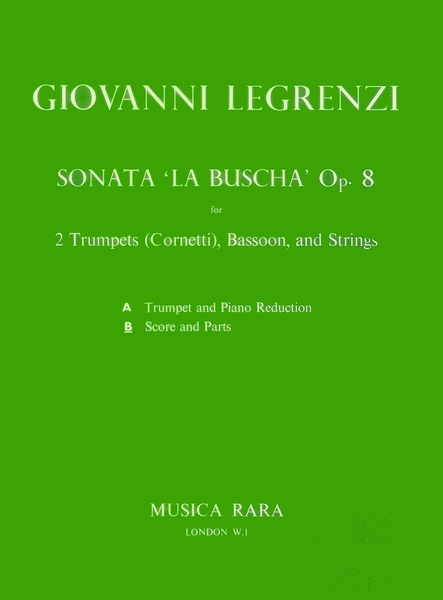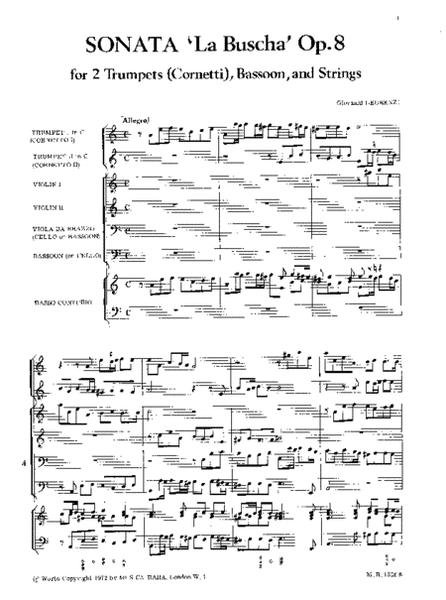Sonata "La Buscha" Op. 8
set of parts
Details
Description
SKU: BR.MR-1528B
Set of parts. Composed by Giovanni Legrenzi. Edited by Robert P. Block. Sonata. Musica Rara. Renaissance/early Baroque. Score and parts. Breitkopf and Haertel #MR 1528b. Published by Breitkopf and Haertel (BR.MR-1528B).ISBN 9790004482223. 9 x 12 inches.
Giovanni Legrenzi was born in Bergamo in 1626 and died in Venice in 1690. Following early appointments in Bergamo and Ferrara, he was made director of the Conservatorio dei Mendicanti, a position parallel to Vivaldi's at the Pieta a few years later. He was named maestro di cappella of St. Mark's (also in Venice) in 1685, holding this position and continuing at the Conservatorio until his death. Apparently following the example of Cazzati at St. Petronio of Bologna, Legrenzi reorganized the orchestra at St. Mark's, and improved its level of performance. As a composer, Legrenzi ranks as one of the best in Italy between Monteverdi and Vivaldi, having produced a large body of music of generally high quality. To his credit must be mentioned 17 operas, a substantial body of secular and Liturgical vocal music, and an enormous amount of chamber music for sacred and secular uses. Included in his chamber works are many solo and trio sonatas, and some others for as many as seven real contrapuntal parts; "La Buscha" is one of these, coming from his opus 8 book of sonatas. (There are four books in all, containing over 60 sonatas.) The Source of this edition was a printed copy ofa set of parts, published in 1671 by Giacomo Monti in Bologna, and presently in the possession of the Civico Museo Bibliografico Musicale in Bologna (Monti, with his rival Marino Silvani, published much of the music produced at St. Petronio.) The present edition is a transcription into modern notation, including a few corrections of printer's errors. Use of accidentals has been modernized, resulting in the removal of many of Legrenzi's that would today be considered redundant. At the same time, a few editorial additions have been placed above the staves in order to eliminate any possible ambiguities. Bar lines were not used consistently; those missing have been replaced without comment. Legrenzi supplied neither articulations nor dynamic markings, and the editor prefers to leave the music in its original state in these respects for those performers who wish to experiment and make their own decisions. Time signatures and tempo indications, except for those in brackets, are Legrenzi's. "La Buscha" offers an unusual overall structure, having three fast movements alternating with two very short slow sections that function more as transitions than as independent sections; and these slow sections are even more abbreviated than those found in some of Legrenzi's other works and in those of his contemporaries. The first movement begins its fugal progress with a strongide a worthy of Bach and develops it, with other equally strong associated ideas from cadence to cadence through points of imitation, maintaining a high level of interest through antiphonal treatment and shifting textures, with only momentary homophonic relief (at m.22). The last movement is imitative, but less rigorously contrapuntal, and relies even more on antiphony and texture. As in the first movement, the final cadence is reached through a piling up of all six parts. Seating arrangements should emphasize the antiphonal aspect of much of this music, since material is often passed between a group consisting of the cornetti and the bassoon, and the violins and viola da brazzo. If wind and stringed bass instruments are available the wind bass should be associated with the cornetti, the stringed bass with the violins. Performance on modern trumpets suggests the use of bass trombone in association with them; and it is entirely possible to play the piece on strings alone, or to substitute oboes for the cornetti. These alterations in instrumentation, should they be necessary, are justifiable both in terms of 17th century performance practice, and by the stylistic identity between string and cornetto parts in this particular composition. But it should be pointed out that the music's overall melodic style owes somewhat more to the tromba manner than to the developing violin style of the same time. The editor therefore suggests that a non-legato manner of playing, which is always appropriate to string music of this period, should be carefully adhered to, since it represents the norm in 17th century wind playing. The realization of the figured bass has been kept relatively simple, to avoid adding further thickness to an already complex texture. Nevertheless, this realization is not intended as a last word on the matter. Players should feel free to try their own ideas, and to simplify or elaborate as taste and skill direct them. To this end, the editor has added to the figured bass a few more figures in brackets which serve to clarify some harmonic situations that might not be obvious at first glance. Robert Paul Block, December 24, 1970, Iowa City, Iowa, U.S.A.


 Share
Share